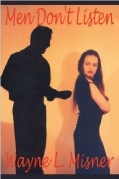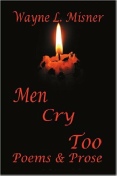
Men Don’t Listen

Two best-selling books by Wayne L. Misner exploring the inner world of men:
Men Don't Listen and Men Cry Too
Order now, by clicking on the "Order Form" button below to display the printer-friendly form, print it, fill it out , and send it along with a money order (sorry, no checks accepted).
Order “Men Don't Listen”
Order “Men Cry Too”
for only
$14.95+$5.00 s/h
for only
$9.95+$3.00 s/h

MenDontListen@aol.com
By Wayne L. Misner
First, I must thank all of you for participating in filling out the questionnaire. Second, I must thank Dr. Irene Matiatos for granting permission to use her web site www.DrIrene.com. Also, she gets credit for programming the questionnaire and helping me with designing it. I compliment all of you for candid answers, which I must believe were painful for many of you. I believe everyone was very honest with their answers. If you cannot be honest with yourself, how can you expect anyone else to be honest with you? Great job!
It's very possible the questionnaire can be skewed in various ways. For a number of reasons more women have filled out the form. It’s possible that men who have been abused may be too embarrassed to admit it. Mirroring the old joke of men not asking for directions, it seems they don’t ask for help either. I must give credit to all of you who were willing to admit you were, or are abusers. The first step of “The Twelve Steps of Domestic Violence Anonymous (VA)”, which I wrote for this article is, “We believe that we have abused and hurt those we love.” Facing the fact you have been the abuser, and admitting it to not only yourself, but to others, starts you on the path to change and become accountable to your friends and family.
Domestic abuse is a reality. Being disrespectful, verbal abuse and violent behavior are part of many families and partnerships. Domestic violence, unfortunately, is not just men being violent. The Department of Justice (6) reports that every 37.8 seconds a man is battered somewhere in the United States . Every 20.9 seconds a woman is battered. In J. Kasper’s article, Parenting Rage - Leashing the BEAST Within(9) , each day in North America, 3 children die from child abuse and 13,700 children are abused and neglected, according to the Children's Defense Fund. The questionnaire answers indicated that both men and women (and in some cases children) were the abusers. Here is just one example of the many that were submitted: “You see, the abuser is my brother, who lives with my mother, and I am trying to keep the family intact based on the request of my mom, who has Parkinson's and has recently become mentally and physically incapacitated.”
Topcondition.com (7) states, “Children between the ages of 3 and 17 are the most violent. 20% of this age group actually abuses their parents. One quarter of all murders are committed by teenagers. 25% of young males have carried a weapon at least one day in the last month.”
Those that are/were abused, women, men, and children as well as those that witness abuse (which usually are small children), have damage that is long-lasting. The men and women (and children) who are abusers must acknowledge that their behavior is wrong. In some cases it is illegal, and if police are involved, they may lock up the abuser with or without the victim agreeing.
Percentages may not add up to 100% because of rounding. Total counts may differ because all questions were not answered on all questionnaires.
I did not correct spelling or grammar on any of the comments submitted.
Now the answers from the questionnaire:
The breakdown of the 100.00% who answered:
1. I am:
The abuser 11.86%
The abused 88.14%
The abuser = Domestic abuse or violence is between partners or any family members. It may be yelling, arguing between siblings, the abuse of an older family member(s), abuse of a friend, forced sex by a significant other, physical or emotional abuse of a child, and any type of violence among same sex partners. I witnessed a father yelling at his son who could not have been more than seven years old. As the father was yelling, the little boy actually started shaking with fear and wetting his pants. This father saw the child shaking and was shocked. He stopped. How sad he can see the results in a little boy but can not see that his behavior does the same thing to his significant other. This episode happened with the father, but it could just as well could have been with the mother; the results would be the same.
No one ever deserves to be abused. Abuse is one method used for control. In reality it is a disorder of power as well. The purpose of abuse is to control the behavior of another person. It is very difficult for some abusers to admit not only to you but to themselves that they are abusers. Some are in a form of denial, and others believe they have a problem but don’t need or trust anyone. They believe they can fix the problem themselves so will not go to counseling, psychologists, psychiatrists, etc. They may be so insecure or afraid of what they will learn about themselves that they don’t want to face it!
Definition of -- My question? = My question can be for any one of the following or a combination of them. It can be a composite of all these many areas:
An expression of inquiry that invites a reply
A subject or point open to controversy
An issue
To express doubt about; dispute
To analyze or examine
A request for data
A situation that presents difficulty, uncertainty, or perplexity
A lack of conviction or certainty
A particular matter or issue that is in dispute, uncertain, or to be inquired into
Uncertainty about the truth or factuality of existence of something
Challenge the accuracy, probity, or propriety of
Place in doubt or express doubtful speculation
You and I as the readers of the answers must interpret the answers given and I will ask My question when the answers don’t seem to fit.
What it is NOT -- it is not about assigning blame!
2. I am:
The breakdown of the 100.00% who answered: (More abused answered the questionnaire from both groups.)
Total Abuser Abused
Male 16.67% 46.47% 53.53%
Female 83.33% 4.94% 95.06%
3. I am:
The breakdown of the 96.96% who answered:
Male Female
Abuser Abused Abuser Abused
Heterosexual 45.88% 52.35% 4.49% 90.44%
Homosexual 0.00% 1.18% 0.12% 0.83%
Bisexual 0.59% 0.00% 0.35% 3.78%
0.29% did not answer this question.
4. I am:
The breakdown of the 99.51% who answered:
Male Female
Abuser Abused Abuser Abused
20 years old or less 1.18% .18% 0.47% 4.96%
Between 21 and 30 10.65% 7.69% 1.54% 20.45%
Between 31 and 40 16.57% 20.71% 1.77% 34.16%
Between 41 and 50 14.79% 14.79% 0.83% 25.53%
Between 51 and 60 3.55% 7.69% 0.35% 8.98%
Over 61 0.00% 1.18% 0.00% 0.95%
0.49% did not answer this question.
MEASUREMENTS OF AGE
1. Chronological Age
Chronological age is a measurement of the time a person has lived---his or her age in years.
2. Physiological Age
Physiological age refers to the degree to which systems of the body have developed relative to chronological age.
3. Intellectual Age
Intellectual age refers to whether a person's intelligence is below, above, or equal to his chronological age.
4. Social Age
Social age compares social development with chronological age. It asks the question; "Does this person relate as well socially as he should for his age?"
5. Emotional Age
Emotional, like social age, compares emotional maturity with chronological age. It asks the question; "Does this person handle his emotions as well as he should for his age?"
MEASUREMENTS OF AGE was written by Dr. Jerome Murray,(10) and there is more personal development material at his web site: http://www.betteryou.com/
5. Do you feel that it is possible that your Intelligence Quotient (IQ) grew to adulthood, but your
Emotional Quotient (EQ) was stunted?
The breakdown of the 99.90% who answered:
Male Female
Total Abuser Abused Abuser Abused
True 62.02% 35.71% 27.98% 3.64% 58.05%
False 37.98% 11.31% 25.00% 1.29% 37.02%
0.10% did not answer this question.
6. IF you feel your EQ was stunted, at what age do you think you are stuck?
Percentage of those who answered “True”
The breakdown of the 61.08% who answered:
Male Female
Abuser Abused Abuser Abused
Below 10 10.58% 1.92% 0.96% 14.26%
Around 11 or 12 6.73% 4.81% 0.77% 8.48%
Around 13 or 14 7.69% 0.00% 1.54% 12.52%
Around 15 or 16 3.46% 12.50% 1.16% 16.76%
Around 17 or 18 9.62% 6.73% 0.00% 15.03%
Around 19 or 20 8.65% 17.31% 1.35% 27.17%
38.92% did not answer this question.
Daniel Goleman Ph.D. is the author of Emotional Intelligence NY:Bantam Books (1995). Goleman’s point that Emotional Quotient includes self-awareness and impulse control, persistence, zeal and self motivation, empathy and social deftness has been accepted in many areas with today’s healthcare professionals.
Dr. John Grohol’s Psych Central web site (11) he states, John D. Mayer and Peter Salovey introduced the term to psychology in a series of papers. They suggested that the capacity to perceive and understand emotions defined a new intelligence. The Mayer-Salovey model defines emotional intelligence as the capacity to understand emotional information and to reason with emotions. More specifically, they divide emotional intelligence abilities into four areas in their four-branch model:
· The capacity to accurately perceive emotions
· The capacity to use emotions to facilitate thinking
· The capacity to understand emotional meanings
· The capacity to manage emotions
Goleman divides up emotional intelligence into the following five emotional competencies:
· To identify and name one's emotional states and to understand the link between emotions, thought and action
· To manage one's emotional states — to control emotions or to shift undesirable emotional states to more adequate ones
· To enter into emotional states associated with a drive to achieve and be successful
· To read, be sensitive to and influence other people's emotions
· To enter and sustain satisfactory interpersonal relationships.
Seeking help: Counselors, psychologists and psychiatrists are helping those with difficulty with low Emotional Quotient (EQ). Our emotions help us to decide how much importance to put on each piece of data we process with our feelings. Some people don’t know how they feel at times; others may misinterpret what they think they are feeling. With the help of a professional each feeling can be discussed and how the person reacts or wants to react. It is imperative that people have the ability to look closely at how and why they make the decisions they make. Those that go into some form of counseling continually improve their E.Q. Although improvement depends a lot on where you’re starting from and how long you are willing to work on it.
7. Do you find yourself trying to control or influence your partner?
The breakdown of the 99.41% who answered:
Male Female
Abuser Abused Abuser Abused
Yes 40.96% 21.08% 4.01% 45.17%
No 6.02% 31.93% 0.83% 50.00%
0.59% did not answer this question.


Help someone by sending them the link to this site: www.mendontlisten.com
Email your relationship questions to: MenDontListen@aol.com and receive a personalized answer.
| Review for Men Don't Listen |
| Review for Men Cry Too |
| Review for Men Don't Listen |
| Review for Men Cry Too |